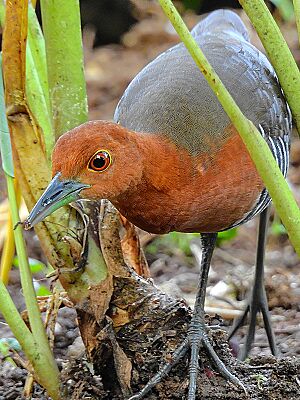Slaty-legged crake facts for kids
Quick facts for kids Slaty-legged crake |
|
|---|---|
 |
|
| Rallina eurizonoides
Mangaon, Maharashtra, India |
|
| Conservation status | |
| Scientific classification | |
| Genus: |
Rallina
|
| Species: |
eurizonoides
|
| Synonyms | |
|
|
The slaty-legged crake, also known as the banded crake, is a small waterbird. It belongs to the rail and crake family, called Rallidae. These birds are known for being a bit shy and often live near water.
Contents
Where Slaty-Legged Crakes Live
Slaty-legged crakes make their homes in swamps and other wet places. They like areas with lots of trees and plants. You can find them across southern Asia, from India, Pakistan, and Sri Lanka all the way east to the Philippines and Indonesia.
Most of these birds stay in the same area all year round. However, some crakes that live in northern regions will migrate (travel) south during the colder winter months.
What Slaty-Legged Crakes Look Like
The slaty-legged crake is about 25 centimeters (about 10 inches) long. Its body is flat from side to side. This shape helps it move easily through thick plants and bushes.
It has long toes and a short tail. Its back is brown, and its head and chest are a reddish-brown color, like chestnuts. The sides of its body, belly, and under its tail have strong black and white stripes. Its throat is white, its beak is yellowish, and its legs are green.
Both male and female crakes look very similar. Young crakes are dark brown all over, but they still have the striped belly and white throat.
How Slaty-Legged Crakes Behave
Slaty-legged crakes are very secretive birds. They like to hide in bushes if they feel disturbed. Even though they are territorial (meaning they defend their space), they are quite good at staying hidden.
They use their beaks to search for food in mud or shallow water. They also pick up food they see. Their diet includes berries and insects. They find these on the ground or by climbing through bushes and plants.
Reproduction and Nesting
Slaty-legged crakes build their nests in dry spots. These nests are usually on the ground or in a low bush. They often choose places near forest paths or streams.
A female crake will lay between 4 and 8 eggs. A study in southern India found that the eggs hatch after about 20 days.



